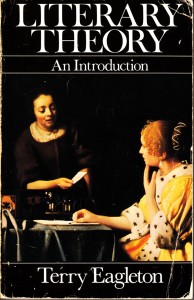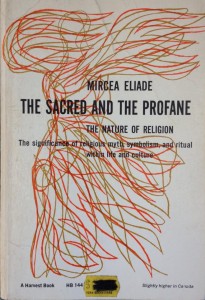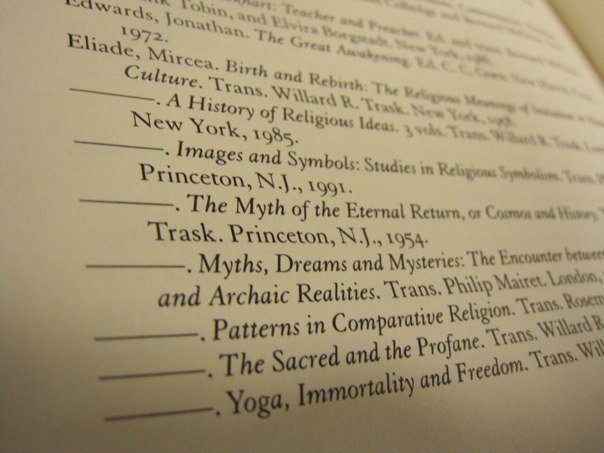 Lots of scholars of religion are focused these days on studying such things as implicit religion, the Nones, or almost any other so-called worldview that people might be said to work with or inhabit (e.g., many are hot on the trail of secularism). What I find interesting about all this is the way in which a professional identity is being recreated, by those who work in this field, in the face of twenty year’s worth of critiques of the category religion itself (pretty obviously the field’s primary organizing concept); for it seems that the more the term is criticized (as being a Latin-based signifier that was exported in the age of colonial contact, making it hardly the universal designator that it was once thought to be — see here for a good primer on this argument) the more data these scholars seem to have to study. Consider the so-called Nones — those who answer a few questions on a survey, about belief in God or attendance at church, and who are now thought by many to comprise a cohesive social, political force: scholars of religion are intent on studying them despite their adamant denial that they’re religious. What’s curious is that while many such scholars criticize those of peers who fail to take the insider’s viewpoint seriously, as they might say, yet here, in the case of the Nones, people’s refusal to identify as religious is hardly a barrier to eager scholars of religion. Continue reading “The Sun Never Sets on the Study of Religion”
Lots of scholars of religion are focused these days on studying such things as implicit religion, the Nones, or almost any other so-called worldview that people might be said to work with or inhabit (e.g., many are hot on the trail of secularism). What I find interesting about all this is the way in which a professional identity is being recreated, by those who work in this field, in the face of twenty year’s worth of critiques of the category religion itself (pretty obviously the field’s primary organizing concept); for it seems that the more the term is criticized (as being a Latin-based signifier that was exported in the age of colonial contact, making it hardly the universal designator that it was once thought to be — see here for a good primer on this argument) the more data these scholars seem to have to study. Consider the so-called Nones — those who answer a few questions on a survey, about belief in God or attendance at church, and who are now thought by many to comprise a cohesive social, political force: scholars of religion are intent on studying them despite their adamant denial that they’re religious. What’s curious is that while many such scholars criticize those of peers who fail to take the insider’s viewpoint seriously, as they might say, yet here, in the case of the Nones, people’s refusal to identify as religious is hardly a barrier to eager scholars of religion. Continue reading “The Sun Never Sets on the Study of Religion”
You Are What You Read, with Russell McCutcheon (Part 2)

For a new Culture on the Edge series “You Are What You Read” we’re asking each member to answer a series of questions about books—either academic or non-academic—that have been important or influential on us.
2. Name one of your favorite theory books.
 With my earlier career in mind, it would have to be Terry Eagleton’s Literary Theory: An Introduction (1983), though I have the 1989 edition, which I bought in Toronto in January of 1991 (evident, again, from my dated front inscription). It too was a book recommended to me by Neil McMullin, and it makes sense to be dated a little later than my copy of The Sacred and the Profane, for (at least as I remember it now), I wasn’t dipping into theory until I’d confirmed that there was a project of some sort to be done on the widespread essentialist understanding of religion as socio-politically and historically autonomous. So having decided there was indeed a project here, at least as applied to Eliade’s one book, the challenge was to start reading as much of his work as I could, and to then be able to make the case that his work exemplified (though it didn’t necessary cause) much wider trends evident throughout the field, and then to come up with a set of tools to critique this approach and identify its practical implications. And that’s where Eagleton’s work came in—helping me to make the shift from seeing words and texts as inherently meaningful, as being in reference to objects in the world that we were talking about, to identifying the apparatuses necessary to signify these scribbles that we call letters, to read them as meaningful—to, as I might now say, operationalize them. Given that I was a sciences undergrad, I’d only taken the virtually mandatory first year English Lit course, with my thick two volume Norton anthology, so reading literary theory, much less the social theory I later came to read, was completely alien to me. Continue reading “You Are What You Read, with Russell McCutcheon (Part 2)”
With my earlier career in mind, it would have to be Terry Eagleton’s Literary Theory: An Introduction (1983), though I have the 1989 edition, which I bought in Toronto in January of 1991 (evident, again, from my dated front inscription). It too was a book recommended to me by Neil McMullin, and it makes sense to be dated a little later than my copy of The Sacred and the Profane, for (at least as I remember it now), I wasn’t dipping into theory until I’d confirmed that there was a project of some sort to be done on the widespread essentialist understanding of religion as socio-politically and historically autonomous. So having decided there was indeed a project here, at least as applied to Eliade’s one book, the challenge was to start reading as much of his work as I could, and to then be able to make the case that his work exemplified (though it didn’t necessary cause) much wider trends evident throughout the field, and then to come up with a set of tools to critique this approach and identify its practical implications. And that’s where Eagleton’s work came in—helping me to make the shift from seeing words and texts as inherently meaningful, as being in reference to objects in the world that we were talking about, to identifying the apparatuses necessary to signify these scribbles that we call letters, to read them as meaningful—to, as I might now say, operationalize them. Given that I was a sciences undergrad, I’d only taken the virtually mandatory first year English Lit course, with my thick two volume Norton anthology, so reading literary theory, much less the social theory I later came to read, was completely alien to me. Continue reading “You Are What You Read, with Russell McCutcheon (Part 2)”
You Are What You Read, with Russell McCutcheon (Part 1)

For a new Culture on the Edge series “You Are What You Read” we’re asking each member to answer a series of questions about books—either academic or non-academic—that have been important or influential on us.
1. Name a book you read early on that shaped the trajectory of your career.
I’d have to say that is w as The Sacred and the Profane by Mircea Eliade—in fact, I have my old 1959 Harcourt Brace & World softcover edition in front of me as I write this. I think I’ve written briefly on this somewhere before, but it was the book that was suggested to me by Neil McMullin, at the University of Toronto, and the person who became my doctoral supervisor, as a book I should go look at to see if I could make the case I wanted to make in what was then emerging as my dissertation topic. “Coz if you can’t make it there…,” I recall him saying, perhaps in some vague reference to Sinatra’s “New York, New York.” For by that point in my graduate studies I had moved from an early interest in the philosophy of religion (yes, I was taking courses on Kant’s first critique, Aristotle’s Metaphysics, courses on a several of Plato’s dialogues, etc.) to an interest not in religion but in how it was studied. It took me some time to eventually move on to being interested in the implications of using the category, however it was defined, so back then my interest was in the problems associated with defining it by reference to some special status held by the objects or sentiments so named. Like all of us, I eventually became so focused on that project, as it developed and then as it was rewritten and published as my first book, that it is difficult now to remember what I thought my project was back then—back in 1990 when I bought this edition in a used bookstore (or so my inscription in the front of the book tells me today); but in the marginalia I find in that book—such as my “Why?” scribbled beside his claim that “Religious man thirsts for the real” (p. 80) or “essence of religion,” circled with “Eliade” written beside it in the book’s concluding sentence:
as The Sacred and the Profane by Mircea Eliade—in fact, I have my old 1959 Harcourt Brace & World softcover edition in front of me as I write this. I think I’ve written briefly on this somewhere before, but it was the book that was suggested to me by Neil McMullin, at the University of Toronto, and the person who became my doctoral supervisor, as a book I should go look at to see if I could make the case I wanted to make in what was then emerging as my dissertation topic. “Coz if you can’t make it there…,” I recall him saying, perhaps in some vague reference to Sinatra’s “New York, New York.” For by that point in my graduate studies I had moved from an early interest in the philosophy of religion (yes, I was taking courses on Kant’s first critique, Aristotle’s Metaphysics, courses on a several of Plato’s dialogues, etc.) to an interest not in religion but in how it was studied. It took me some time to eventually move on to being interested in the implications of using the category, however it was defined, so back then my interest was in the problems associated with defining it by reference to some special status held by the objects or sentiments so named. Like all of us, I eventually became so focused on that project, as it developed and then as it was rewritten and published as my first book, that it is difficult now to remember what I thought my project was back then—back in 1990 when I bought this edition in a used bookstore (or so my inscription in the front of the book tells me today); but in the marginalia I find in that book—such as my “Why?” scribbled beside his claim that “Religious man thirsts for the real” (p. 80) or “essence of religion,” circled with “Eliade” written beside it in the book’s concluding sentence:
The former seek to understand the essence of religion, the latter to discover and communicate its history.
—I see traces of an earlier self working out an idea, applied first to that specific book, that went in directions that writer surely couldn’t have imagined. But it‘s kind of fun now to page through it and see, beside Eliade’s claim that “The cosmic structure of these objects is obvious,” that younger hand having written: “nothing, when it comes to symbolism, is obvious!”
Here? No Evil
 I found an image, not long ago, while hunting around for something new for Facebook, in which three silhouettes gestured the proverbial “three wise monkeys” poses, with the words “the sacred and the profane” written across it. Mulling it over, it seemed to be a rather useful way into the problem of how those technical terms are used by scholars of religion. Continue reading “Here? No Evil”
I found an image, not long ago, while hunting around for something new for Facebook, in which three silhouettes gestured the proverbial “three wise monkeys” poses, with the words “the sacred and the profane” written across it. Mulling it over, it seemed to be a rather useful way into the problem of how those technical terms are used by scholars of religion. Continue reading “Here? No Evil”
Eliade Has Not Left the Building
 There’s been lots of buzz, over the past decade or so, about material religion or embodied religion, as if this apparent emphasis on the empirical, the contingent, the historical, somehow gets us out of what many now see as the old rut of studying disembodied beliefs alone. Continue reading “Eliade Has Not Left the Building”
There’s been lots of buzz, over the past decade or so, about material religion or embodied religion, as if this apparent emphasis on the empirical, the contingent, the historical, somehow gets us out of what many now see as the old rut of studying disembodied beliefs alone. Continue reading “Eliade Has Not Left the Building”
